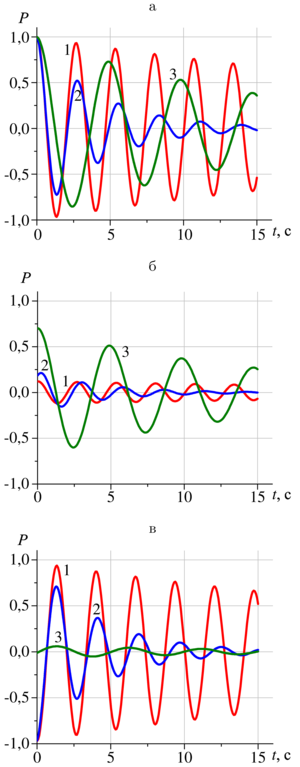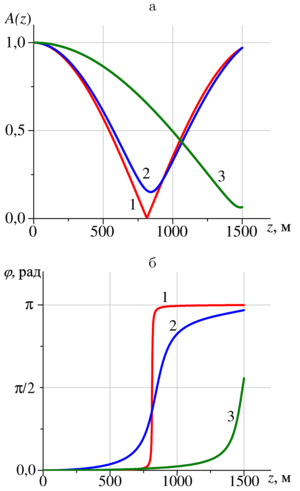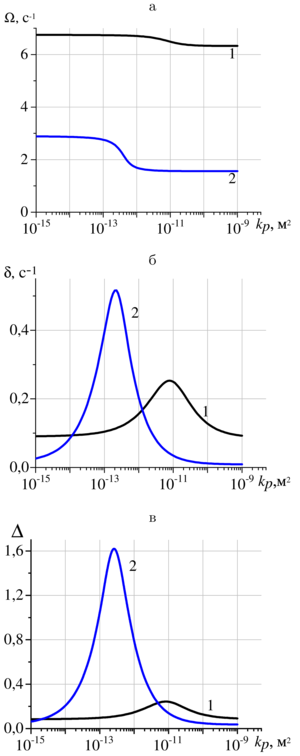

In the oil industry, an important aspect in the production of hydrocarbons is the control of the state of the well and the study of the near-wellbore zone adjacent to it. For this purpose, various geophysical well survey methods (GIS) are used. One of the methods of well logging is acoustic spectroscopy of wells, where the characteristics of the well and reservoir can be studied by means of excitation of natural oscillations of the fluid. In this paper, the problem of natural oscillations of a fluid in a vertical well, which arose as a result of a sharp opening or closing of the well, is investigated. To describe this process, a mathematical model of natural oscillations of the liquid column in the well, which communicates with the reservoir through the permeable walls of the open area, is constructed using the mass and momentum conservation equation in the well area, the mass conservation equation in the open area of ??the well, and the filtration equation in the reservoir. Taking into account the initial and boundary conditions, an analytical solution was found in the form of standing waves to determine the pressure and velocity of oil in the well. The dependences of the oscillation frequency, decrement and damping factor on the reservoir permeability are shown, the pressure dynamics in the well is given and the amplitude of the oscillations is considered. A comparative analysis of changes in such indicators as oscillation frequency, decrement and damping coefficient has been carried out. The influence of such parameters as the length of the bottomhole zone and the permeability coefficient on the nature of the change in the natural fluctuations of the fluid has been established.
well,
oil,
water hammer,
natural fluid vibrations,
vibration frequency,
damping coefficient and decrement
The oil industry is the largest industry, which has a fairly developed structure, but does not stop developing to this day. The beginning of industrial oil refining dates back to the middle of the 19th century, after which powerful oil refineries began to appear and oil became the most important part of the economy of the whole world. It should be noted that from year to year the process of oil production becomes more complicated. The reason for this is the deterioration of the technical condition of wells, an increase in the share of hard-to-recover hydrocarbon reserves and a decrease in the productivity of production wells. To eliminate these problems, it is necessary to monitor the state of wells and the parameters of the bottomhole formation zone, as a result of which various geophysical well survey methods (GIS) (electrical, radioactive, acoustic, magnetic, thermal, etc.) are developed and applied for their technical evaluation. Acoustic spectroscopy of wells is one of the well logging methods, which involves the excitation of natural oscillations of the liquid column in the well, and further, based on the obtained wave characteristics, it makes it possible to determine the length of the liquid column, the diameter of the well, and the reservoir characteristics of the formation adjacent to the well. Fluid vibrations can be excited by hydraulic shock in the wellbore. Note that this formulation of the problem is interesting in the case when the process of water hammer occurs in real conditions during the operation of oil wells (for example, during a sudden stop of pumps during a breakdown).
This paper presents a method for testing wells, which involves the excitation of natural oscillations of the liquid column in the wellbore by means of hydraulic shock. A mathematical model of the process of natural oscillations of the liquid column in the well, which communicates with the reservoir through the permeable walls of the open area, is constructed, for the description of which the equations of mass and momentum conservation in the well area, the equations of mass conservation in the open area of the well are used. A solution in the form of standing waves for the pressure and velocity of the fluid in the well is found. A transcendental equation is obtained for determining the frequency, period and damping coefficient of oscillations. The dependences of the oscillation frequency, decrement and damping factor on the reservoir permeability are shown, the pressure dynamics in the well is given, and the amplitude of the oscillations is considered. A comparative analysis of changes in such indicators as oscillation frequency, decrement and damping coefficient has been carried out. The influence of such parameters as the length of the bottomhole zone and the permeability coefficient on the nature of the change in the natural fluctuations of the fluid has been established.




